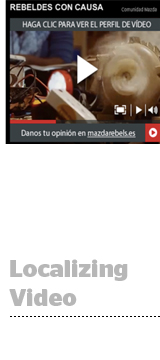 Campaign briefs are increasingly filled with demands for advanced creative versioning, forcing agencies into closer collaboration with ad tech providers.
Campaign briefs are increasingly filled with demands for advanced creative versioning, forcing agencies into closer collaboration with ad tech providers.
It’s one of the reasons why Mindshare partnered with dynamic creative optimization platform Spongecell last fall to support a Mazda Rebels campaign, featuring a series of short films profiling engineers and innovators on the cusp of the “next big idea.”
It’s important to note Mazda works with a range of WPP agencies, including a specialized shop called Garage Team Mazda, which WPP founded in 2010 to support much of Mazda’s North American marketing and creative needs.
For this particular campaign, Mindshare UK used Spongecell’s dynamic creative and data tools to convert Mazda Rebels’ creative into nine different digital videos localized for 23 markets.
The videos each contained unique creative and calls to action to encourage consumers to “Visit MazdaRebels.com” and vote for their favorite filmmaker. In turn, Mazda would help fund the winning creator’s pet project.
“For each video, there were 10 or so component parts Spongecell could chop and change dynamically to customize the creative in real time,” said Adam Ray, head of programmatic for Mindshare. “The volume we got was huge – [about] half a million [views] and hundreds of thousands of votes, so it worked well to generate engagement with our target audience.”
By dynamically swapping subheads, background images, calls to action and localizing text for French and Spanish audiences, for instance, the average time spent on Mazda’s videos was 47.5% above the benchmark with a 29% higher completion rate.
Although Mindshare has used Spongecell’s DCO tools for several years, Spongecell recently rolled out a platform called CORE, which integrates its pixel server/creative optimization and reporting tools with a number of data management/demand-side platforms and ad servers.
“We were more interested in integrating with and playing with the ad servers than being an ad server ourselves, since it’s a piece of the stack that’s pretty commoditized,” said Ben Kartzman, CEO of Spongecell. “We kind of sit on top of the ad server, ingest data and turn that into dynamic variations for sequential messaging in real time.”
Spongecell said CORE isn’t a data management platform, but instead serves pixels and syncs cookies with a client’s DMP or data partners.
Agency clients like Mindshare typically come to Spongecell when they want to do more programmatic decisioning around their creative.
It often sits on top of an agency or advertiser’s database or ad server, and can match creative variables to different audience targets based on loyalty card data, for example.
Buyers can upload different creative assets and to “auto-optimize” an output based on specific product deals, countries, audience segments or period of time, which goes well beyond rich-media optimization, Kartzman said.
 “As we saw this year with the death of flash and rise of HTML5 – the desire by advertisers to use data to influence creative will challenge an old-school rich-media business for sure,” he said. He noted how PointRoll sold for $20 million to Sizmek.
“As we saw this year with the death of flash and rise of HTML5 – the desire by advertisers to use data to influence creative will challenge an old-school rich-media business for sure,” he said. He noted how PointRoll sold for $20 million to Sizmek.
Spongecell’s platform is designed to target based on factors like location and site visitation habits. It then builds multiple combinations of creative variables dynamically based on what is known about the user.
Although Mindshare’s largest multinational clients like Unilever and Kimberly-Clark have undergone hefty build-outs of private trading desks and first-party data onboarding projects, Ray said doing dynamic creative at scale is a relatively new undertaking for many brands.
“The realization that it’s important is starting to hit home,” he said, adding the caveat that “when you’ve got big scale and millions of records across 80 different brands, it’s a massive endeavor to onboard that data just to be smart and buy against [targeted audience segments]. The next step then is to inform the creative.”













